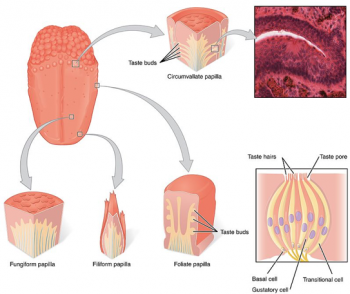By Vidya Rajan, Columnist, The Times
Lead in paint and gasoline was banned in the 1970s because it causes brain damage by downregulating the production of brain-derived neurotrophic factor (BDNF) [1]. BNDF is an important growth factor for brains to grow and develop properly. Therefore, banning lead from gasoline makes sense – after all chemicals in fumes get breathed in, enter the circulation, and get to the brain. But paint? Paint sticks to walls and mostly stays there. How is that a problem? It turns out it is a problem because little kids like to eat lead paint. Lead paint chips are sweet. Little children who are attracted to all things sweet eat paint chips flaking off walls, and suck on toys painted with sweet lead paint. Brain damage follows.

Figure 1: Taste buds on the mammalian tongue. Taste buds take up different shapes on different parts of the tongue, but all contain clusters of taste receptors from the five categories of sweet, salty, umami, sour and bitter. The receptors trigger the activity of nerves that carry the information for decoding in the brain. Reproduced under CC BY 4.0 license from Wikimedia. Original image from Version 8.25 of the Textbook OpenStax Anatomy and Physiology, Published May 18, 2016.
Our sense of taste is primarily shaped by evolution to seek out foods that are nutritive and reject foods that might kill us. Thus, we love sweet, fatty, salty and meaty foods for their associated calories, electrolytes and amino acids. On the other hand, we reject bitter-tasting foods, which in nature are associated with poisons or spoilage, both of which can lead to the accumulation of toxins; many toxins taste bad because the evolutionary rationale of the organisms that produce the toxins is to avoid becoming a tasty snack. Secondly, there is an emotional component to food that can have evolutionary benefits. Good tasting food make us feel good, and that connection helps with remembering where to find it, because all animals are hardwired to seek out pleasurable stimuli. So, taste links to more than just what’s good or bad for us. It makes memories. In this article I will examine the links between taste, emotion and memories and the question – do other animals, such as bees, experience food the same way as we do.
In vertebrates, the mouth is closely associated with the olfactory organ, the nose, both in location and in function. Taste is perceived in the mouth by taste receptors, which are organized into clusters of “taste buds”. Do you remember the sketch of the tongue with regions on it that are sensitive to a specific taste? Well, go ahead and forget it – it’s wrong. In actuality, individual taste buds respond to all the tastes [2], because each has a conglomerate of cells containing receptors that are specialized for recognizing one of the cardinal tastes: sweet, salty, sour, bitter and savory (also called umami, a meaty taste that is related to the presence of nutritive amino acids) (Figure 1). Further, the smell of food we chew wafts up through the oral cavity into the nasopharynx where volatile signatures contribute depth to the taste and mouthfeel, thereby enhancing the gustatory experience.
Taste cells are specific to a single taste because of the presence of receptors for that taste. The receptors fall into three major categories. The first class of taste receptors sends a signal across the membrane into the taste cell when it contacts a tastant molecule, but the tastant molecule remains outside the cell. Therefore, these receptors are analogous to doorbells which make a sound inside a house. The second class of receptors are transporters which move the tastant molecule into the taste cell, thereby triggering a signal based on the action of the molecule inside the cell. This second class therefore is more analogous to entering a house through a door and then shouting. The third class are also transporters, but they move ions, charged molecules that are common in salty and acidic foods. These are like cat-flaps in doors. They synergize with other tastants, but also operate on their own. The details are more onerous: there are redundancies in recognition, with multiple varieties of both the doorbell-, door- and cat-flap-type receptors operating. Triggering a taste cell leads to an impulse carried by sensory (afferent) nerves to taste centers in the brain. The location of the mouth and nose relative to the brain causes the nerve impulses to pass through limbic (primitive) brain regions including the thalamus and hippocampus. Both of these structures are important for association of stimuli to emotion and then processing the connection into memory. However, the specific way they link up – whether each sensory cell sends a pure taste impulse to the brain where the tastes are combined, or the combination and processing occurs in the taste bud itself, is not known for certain, and evidence for both has been presented. In mice, behavioral responses related to sweet and bitter taste can be achieved by stimulating specific neurons in the brain’s taste center. So, even if specific taste regions are not encoded on the tongue, apparently they are in the brain, at least in mice [3]!
Most of the early work on taste receptors was actually carried out in the fruit fly, Drosophila. Taste receptors in these flies are mediated by gustatory receptor neurons (GRNs) sensitive to two specific tastes: bitter and sweet. Presumably these correlate to plant poisons to avoid and nutritive nectar to pursue. These animals are small and they walk on their food, so it makes sense for them to have GRNs dispersed around their body to include any portion that may encounter food: the mouth including the proboscis and pharynx, wings, and legs. Other neurons are sensitive to water and to carbonation. In a fly, stimulation of the GRNs of the leg and wing with a palatable taste causes a proboscis extenstion reflex (PER), which causes the fly to start to feed. PER is suppressed when a noxious tasting substance is encountered. Thus, gustatory neurons are linked to motor neurons [2]. There is also evidence that a circuitry independent of taste but operating on the calorie-association of food rewards high energy foods with a dopamine release, stimulating the pleasure circuit. Thus it is not merely the taste, but also the energy value of food that is rewarded.
It is known that honeybees communicate the locations of food sources using the “waggle dance” and thus they must retain memories of the quality and location of the source. Memories in invertebrate brains are made in structures called “mushroom bodies”, although it is not clear if the memories associate with the taste or the smell of the nutrient. Odorant receptors are found in the mushroom bodies may help to link the nutrient source with the location memory. For example, it is well known that adding a drop of an odorant, such as chlorine or essential oil, to water, helps bees to learn its location. It must follow that the samples that bees share of the nutrient may also carry the odorant. This raises other questions: do gradients of volatile chemicals in the air help a bee to navigate to the nutrient as well as remember it? Also, the type of nutrient matters. It turns out from recent (in as-yet unreviewed) research posted in the preprint server, bioRxiv [https://doi.org/10.1101/432518] that male and female native bees from both solitary and social groups studied in a New Jersey meadow prefer different flower types. Males prefer to forage at nectar-rich flowers, presumably to fuel flight. Female bees seek out flowers that are both pollen- and nectar-bearing. Female bees lay eggs and this requires proteins. Drone honeybees, on the other hand, are moochers on the sweet labor of their women. Ah, the inequities of gender.
Finally, back to the sweetness of lead. Turns out that not all that is sweet is nutritive – neurotoxic lead somehow triggers sweet receptors. Lead has the chemical symbol Pb, short for plumbum. Lead was used widely in plumbing in the Roman era, and the term plumbing references this use. Maybe it sweetened the water carried in lead pipes, but the Romans expanded its use to other containers such as wine pitchers. They also added “sugar of lead”, lead acetate, to their wine to sweeten it still further. It is hypothesized by historians that this leaden diet contributed to the decline of the Roman empire. It will not escape your notice that the recent woes of lead leaching into water in Flint, Michigan, came from lead fittings in water pipes. Apparently, we humans don’t learn too well from history, despite two millenia of awareness of the dangers of this sweet, but poisonous, substance.
- Stansfield, K.H., et al., Dysregulation of BDNF-TrkB signaling in developing hippocampal neurons by Pb2+: Implications for an environmental basis of neurodevelopmental disorders. Toxicological Sciences, 2012. 127(1): p. 277-295.
- Yarmolinsky, D.A., C.S. Zuker, and N.J. Ryba, Common sense about taste: from mammals to insects. Cell, 2009. 139(2): p. 234-244.
- Peng, Y., et al., Sweet and bitter taste in the brain of awake behaving animals. Nature, 2015. 527: p. 512.






